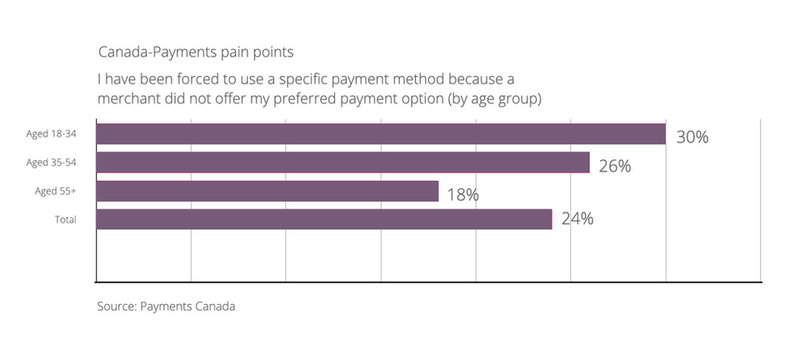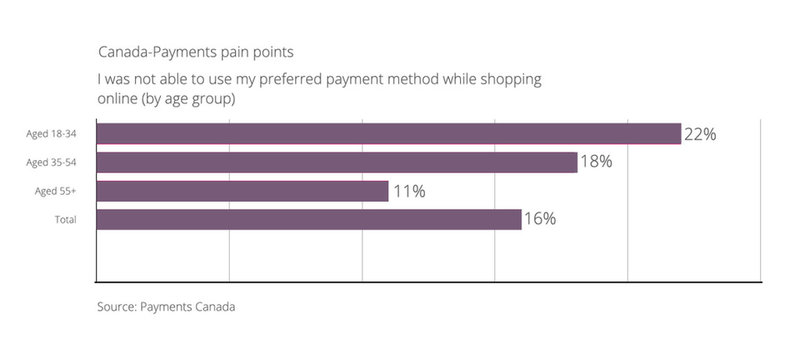PRODUCTS & SERVICES
Canada: payments challenges and opportunities
Canadian consumers continue to seek more payment choices, including to pay their bills and taxes. In turn, the payments ecosystem and the pace of innovation within Canada’s payments ecosystem continues to accelerate

T
he focus for consumers is on the need for faster, more convenient, and secure payment experiences across a multitude of platforms — from contactless and mobile payments, e-commerce, and electronic P2P transfers.
Consumer payment options and frictionless transactions are critical to drive business advantage in an era of digital payments. And fuelled by the pandemic, Canadians are seeking more payment choices.
Specifically, consumers have an appetite for seamless payment experiences that are frictionless and less complex. In fact, almost three in five Canadians (57%) report experiencing some form of payment friction in the past six months, with payment choice constraints being cited as a key reason.
While there is commonality across different generations, there are intricacies and differences in payment frustrations and pain points by age demographic. Whereas younger Canadians (ages 18-34) are more concerned about being able to make and receive payments faster, older Canadians (ages 55+) are most concerned about improving payment security.
Pain points and frustrations
Research released by Payments Canada highlights that Canadians struggle more with sending or receiving money internationally than any other payment use. The research shows that only around one in five Canadians (22%) report finding it easy to send or receive money internationally.
But it is payment constraints and limits on transfer amounts that are the most prevalent payment pain points
Almost three in five Canadians (57%) report experiencing some form of payment friction in the past six months. These encounters primarily relate to either payment choice constraints (when consumers are not able to use their preferred payment method or are forced to use a payment method not of their choosing), or limits on transfer amounts.

Source: Payments Canada
Security and lack of merchant payment choices fuel frustration
Security concerns differ by age demographic. Beyond fees, overall, the biggest payment frustrations Canadians report relate to security with executing payments (by 29% of Canadians), as well as the lack of merchant payment options (with 29% who report being frustrated by stores not offering contactless payments, and 23% who are frustrated when not all payment methods are accepted).
However, payment frustrations differ by age demographic with noticeable differences between younger and older cohorts.
Younger Canadians (18-34) are more concerned about being able to make and receive payments faster. In other words, fewer steps to complete, shorter wait time to process online payments, shorter wait time to send/receive electronic transfers), as well as having more payment method choices at merchants, and limits on transfer amounts.
Not being able to use contactless payments (card or mobile tap-to-pay) for store purchases is a key payment frustration for young Canadians (31%), which is to be expected given that they are more likely to tap their cards and use mobile wallets.
Older Canadians (55+) are more concerned about improving payment security (33%) when making a payment or executing a transfer, and safety convenience (24%), ie., not having to remember passwords/PIN when making a payment or transferring funds.

Source: Payments Canada
Nearly half of Canadians experience frustration when paying their bills
Nearly one in two Canadians (48%) experience some form of frustration when paying their bills, with younger consumers being significantly more likely to report frustrations (65%).
Beyond not having enough money, the primary pain points experienced by young Canadians (18-34) when paying their bills are remembering the due date, the slowness for transactions to appear on the account, having to pay extra fees, not being able to pay by credit card, and not having more bill payment choices.

Source: Payments Canada
Sending and receiving money internationally - the biggest opportunity for improvement
Canadians struggle more with sending or receiving money internationally than any other payment use.
Young Canadians (18-34) are most likely to find it difficult sending/receiving money internationally (19%). They also frequently send money internationally (46%), more than any other age group.
Besides fees, concerns about security and overall transparency (not knowing the currency exchange rate before the transaction is settled and cleared); and slowness for transactions to appear on the account represent the biggest challenges reported by young Canadians when sending money internationally.
Over one in three new Canadians (38%) frequently send money abroad, with a key concern being the slowness for transactions to appear on the payee account (13%).

Source: Payments Canada
P2P frustrations also differ by age
In general, Canadians who make frequent P2P payments look for payment methods that are convenient to use, fast, secure and allow them to track their payments.
There are noticeable differences between young and older Canadians concerning the payment types they choose, and the nature of the payment frustrations and challenges they face when making P2P payments.
Interac e-Transfers is the main method of choice for making P2P payments among young Canadians (70%), while older Canadians (55+) use a wider variety of methods. Interac e-Transfers account for 57% with bank transfers (21%), cheque (9 per cent), and cash accounting for 8%.
Young Canadians are mostly concerned about reducing or eliminating fees, reducing wait time for the payment to go through, and making the process easier for initiating a P2P transfer.
Older Canadians' security concerns
Enabling Canadians to directly pay their taxes by credit card will help reduce payment friction reports Payments Canada.
Canadians prefer to electronically pay government taxes, either through their online banking account using bill payment, via a pre-authorised debit, or credit card.
Nearly one in five Canadians prefer to pay their taxes using a credit card (17%) but are not able to directly make payments to the Canada Revenue Agency using this payment method. Instead, they have to go through a third-party payment service provider and pay extra fees in order to pay their taxes by credit card.
This is a potential source of frustration for Canadians preferring to pay this way, creating unwanted complexity and expense for consumers.
The bottom line: Canadians want more choice
While the payments ecosystem continues to constantly innovate to meet shifting consumer needs and expectations, with fewer steps to complete transactions, shorter wait times to process online payments and enhanced security features, at the core of consumers’ payment needs is the message that Canadians want choice.
Consumers expect merchants and businesses to provide payment options to meet their preferences. That means at the point of sale, for online purchases or to pay their bills and taxes.
Speed, security, convenience, traceability and having payment options are all key factors that impact Canadians’ payments experience. And that can make the difference between a frictionless experience and creating frustration.
With more and more Canadian consumers making purchasing decisions based on their payment preferences, this points to a significant opportunity for businesses and organisations to continue to expand payment options to drive efficiencies and enhance their consumer experience.
Payments Canada believes that the introduction of Canada’s real-time payment system will deliver innovative and convenient payment options that provide more choice to businesses and consumers.
Payments Canada’s Government Cheque Reduction Initiative will also support convenience for consumers and businesses, in the form of faster, more secure access to funds, increased payments processing efficiency and reduced operational costs.